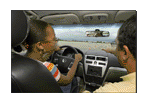Quinn-Direct: How to Keep Your Calm When Teaching Your Child to Drive
 |
LONDON, Sept. 13 -- So your son/daughter has their provisional licence, is learning to drive and you are probably paying for their lessons. You know that money doesn't grow on trees but you also want your child to get as much instruction and practice as possible. If you are a bit strapped for cash or want to supplement your child's lessons with some extra practice, you may want to consider taking him/her out in your car. However, this can be stressful and has the potential to go wrong, so we've put together this handy guide to keeping your sanity!
Are you suitable to teach?
Before you discuss taking your son/daughter out to practice driving, you may want to think over whether you are suitable to take your child out on the road. Some people's temperaments are better suited to teaching people than others. Calmness and patience are required to teach driving. Is this you? Are you likely to lose patience or your temper? Is your son/daughter hot-headed, impetuous or stubborn? Remember that an argument that starts while teaching someone to drive is potentially very dangerous. If in doubt, leave it to a professional instructor for young drivers.
Prepare yourself and your car!
Use this check-list to get you and your car ready:
-- Car insurance is compulsory for all learner drivers. Therefore you
must contact your car insurance provider to add the learner driver as
a named driver on your policy or take out a separate insurance policy
for the learner driver. There are several providers that offer
dedicated young person's car insurance and insurance for provisional
license holders. Make sure the insurance provider is aware that the
learner has a provisional license and will be learning to drive using
the car and take note of any restrictions
-- Get an up-to-date copy of the Highway Code and brush up on everything
that you've forgotten. Remember that you don't want your offspring to
pick up any bad driving habits that you may have developed over the
years!
-- The supervising driver must be at least 21 years old & have a full
driving license (for the type of vehicle they are supervising in -
manual or automatic), which must have been held for a minimum of three
years
-- The driver must meet the minimum eyesight standards
-- Ensure that your car is in a safe and legal condition and that the
clutch, lights and brakes work properly. If there are any problems,
get it sorted out by a mechanic.
-- Put the 'L' learner drivers sign (or D in Wales) on the front and back
of your car.
Teaching tips
When teaching your child to drive, bear the following tips in mind to help them have an enjoyable experience:
-- Try to refrain from making comments like 'What are you doing?' will
put your charge ill at ease and create a bad atmosphere.
-- Don't shout orders such as 'Brake now!' as they will also make the
young driver nervous.
-- Make sure you tell your child at the beginning of the lesson what
skills you will be practising today, e.g. parking. This will help them
feel prepared.
-- Whilst they are driving, calmly comment on the road ahead and point
out any hazards they may encounter.
-- Give praise where it's due and also point out things that they have
done wrong. Just remember to remain calm!
-- Try to pick an area where there is little traffic until your charge
feels more confident. Start off with a quiet residential area, and
then move to busier areas until the learner can cope with busy town
centres and dual carriageways.
-- Put emphasis on 'Mirror, signal, manoeuvre' so that this becomes
ingrained in the learners mind. Do this for other procedures such as
parallel parking.
-- Ensure that seat belts are worn at all times and mobile phones are not
used.


